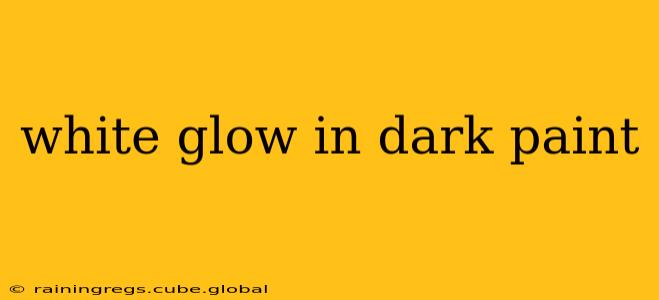Glow-in-the-dark paint has become increasingly popular for creative projects, home décor, and safety applications. While many vibrant colors are readily available, achieving a bright white glow can be challenging. This comprehensive guide explores the nuances of white glow-in-the-dark paint, addressing common questions and providing insights for achieving the best results.
What Makes Glow-in-the-Dark Paint Glow?
Glow-in-the-dark paint, also known as phosphorescent paint, contains phosphors – special materials that absorb energy (usually light) and then slowly release it as light over time. The brighter the initial light source, and the longer the exposure, the brighter and longer the glow will be. White glow-in-the-dark paint uses phosphors that emit light across a broader spectrum to create the appearance of white, unlike colors that utilize specific phosphor combinations to produce a single hue. This broader spectrum emission can sometimes result in a slightly off-white or even a pastel appearance depending on the specific phosphor blend used.
How Long Does White Glow-in-the-Dark Paint Glow?
The duration of the glow depends on several factors, including the quality of the paint, the intensity and duration of the charging light source, and the surrounding environment. High-quality paints can glow for several hours, while cheaper varieties might only glow for a short time. Expect a gradual decrease in brightness over time; the initial bright glow will fade into a softer luminescence before disappearing completely. Generally, you can expect a noticeable glow for several hours with quality products under sufficient charging conditions.
Is White Glow-in-the-Dark Paint as Bright as Other Colors?
This is a common misconception. While achieving a truly bright, pure white glow is difficult, advancements in phosphor technology are continuously improving the luminosity of white glow-in-the-dark paint. However, it's generally true that other colors, particularly those utilizing specific phosphors that emit light in a narrower, more concentrated wavelength, may appear brighter than white. White requires a blend of phosphors emitting light across a wider spectrum, which can result in a less intense glow compared to single-color options.
What Are the Best White Glow-in-the-Dark Paints?
The market offers several brands and types of glow-in-the-dark paint, and the "best" option will depend on your specific needs and budget. Look for paints that specify high luminance and long afterglow times in their descriptions. Researching reviews from other users can be helpful in making an informed decision. Remember to check the application instructions carefully and follow them diligently for optimal results.
How Can I Make White Glow-in-the-Dark Paint Glow Brighter?
To maximize the brightness and duration of your white glow-in-the-dark paint, ensure it's adequately charged. Expose the painted surface to a strong light source, like direct sunlight or a UV lamp, for an extended period before turning off the lights. The longer the charging time, the longer and brighter the glow will last. The environment also plays a role; cooler temperatures generally help preserve the glow for longer periods. Avoid applying the paint to surfaces that absorb or block light, as this will significantly reduce its glowing potential.
What Surfaces Are Best for White Glow-in-the-Dark Paint?
Most glow-in-the-dark paints adhere well to smooth, non-porous surfaces such as glass, metal, and plastics. Porous surfaces like wood or plaster may absorb some of the light, resulting in a less intense glow. Proper surface preparation, including cleaning and priming (if necessary), is crucial for optimal adhesion and brightness.
Conclusion
While achieving a vibrant, intensely bright white glow-in-the-dark effect might require some experimentation and careful selection of paint, the results can be incredibly rewarding. By understanding the science behind the glow and following the tips outlined in this guide, you can successfully create stunning, luminous projects using white glow-in-the-dark paint. Remember to prioritize quality paint, ample charging time, and appropriate surface preparation for the best possible outcome.
